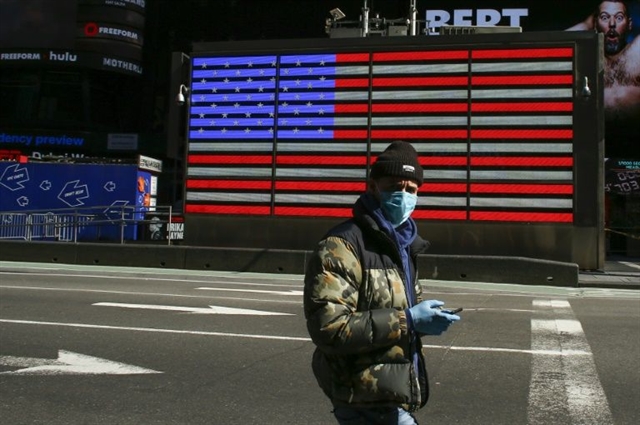 Opinion
Opinion

A face mask, by definition, is used to cover the nose and mouth, but there's more than a face under the mask.

|
| A man wears a face mask as he checks his phone in Times Square on March 22 in New York. AFP/VNA Photo |
By Trang Pham*
A face mask, by definition, is used to cover the nose and mouth, but there's more than a face under the mask.
As the COVID-19 pandemic surges globally, a huge amount of information is being pumped out daily, much of it confusing and/or controversial. Amid this has been heated debate about the use of face masks. In some instances, this uncertainty has resulted in disturbing incidents. A few weeks ago, an Asian-American student in Bolsa Grande High School, California was racially discriminated against, seemingly as she was wearing a mask.
Different health guidelines
The US Centers for Disease Control and Prevention recommends healthy people not wear a face mask to protect against the coronavirus.
According to Dr Nancy Messonnier, director of the Center for the National Center for Immunisation and Respiratory Diseases (NCIRD), the use of face masks is not routinely recommended for the public to prevent respiratory illness, and certainly not at this time.
The masks may give the wearer a false sense of security against the coronavirus, which may lead to them neglecting fundamental hygiene measures and masks can also be a source of infection and transmission when not used correctly, medical experts have said.
These practitioners fear that hoarding facemasks could lead to a shortage for health care providers.
US Surgeon General Jerome Adams posted on his Twitter: “Seriously people - STOP BUYING MASKS! If healthcare providers can’t get them to care for sick patients, it puts them and our communities at risk!”.
He has since walked back the comments.
Doctors are on the frontline of this fight against COVID-19, yet many do not have enough protective equipment. Their battle against the coronavirus is fraught with danger, which also means the whole community is in peril.
The CDC has legitimate reasons for their concerns and recommendations. However, in many Asian countries such as China, South Korea and Việt Nam, the wearing of masks in public is now mandatory. According to many infection prevention experts, there are milder cases without clear symptoms but are highly infectious and there is evidence of asymptomatic transmission.
Ivan Bui, an epidemiologist, explained that “wearing a mask can help to reduce the risk of being exposed to potentially infective respiratory droplets”, and can limit the spread of certain respiratory diseases, including COVID-19.
Bui stressed that wearing a mask should go “together with hand hygiene and other infection and prevention control measures”.
A study conducted by a group of researchers of Public Health England (HPA) compared different types of masks in protecting people during an influenza pandemic. Their findings suggest that both masks help “prevent droplet transmission from infected individuals” and “would be better than no protection”.
By March 29, according to Johns Hopkins University’s Coronavirus Resource Center, the US surpassed China for the highest number of confirmed COVID-19 cases, recording some 124,000 cases. The figure has since passed 300,000 with more than 8,000 deaths.
The number of new cases in the US has been rising rapidly while those reported in China and South Korea began to slow down about three weeks after the first 100 cases were reported.
Chinese health officials believe wearing masks is one of the easiest and cheapest means of fighting the outbreak.
Speaking to Science magazine, George Gao, Director-General of the Chinese CDC said: “The big mistake in the US and Europe, in my opinion, is that people aren’t wearing masks.”
Different cultures
Long before COVID-19 appeared in Asia, the wearing of a face mask has been accepted and practiced. People wear masks for all sorts of reasons: limiting the risks of infection, of pollution, protecting from the sun, and keeping their face warm. The hazardous air pollution in many Asian cities may well explain the habit of wearing masks to protect the wearer fromdirty air.
Face masks have also become fashionable, with vividly coloured and decorated options across the continent. Facemasks of varying quality can be easily found in many countries, rather than solely in hospitals.
The uses of face masks seem to be unfamiliar to many non-Asian people and for many Americans, a face mask is only for medical purposes, and anyone (apart from medical practitioners) wearing a mask must be sick.
The face mask has also been associated with the SARS outbreak in 2003 in the minds of some.
Fear of the unknown creates anxiety and the face mask has become a symbol of this growing fear.
Recommendations on face masks vary across countries, but one certainty is that whether “to mask, or not to mask”, is becoming an important question. VNS
* Trang Pham is studying master degree majoring in digital media strategy at Communication/Journalism Faculty, Georgia State University